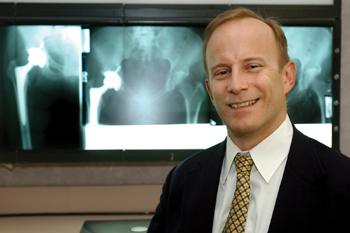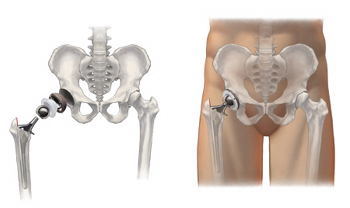
Dr. Andrew Shinar is one of the first in Tennessee to perform the minimally invasive hip replacement surgery. (photo by Dana Johnson)
New hip procedure reduces pain, time

The stem implant may be held in place by either using the special cement for bones, or by making it fit very tightly in the canal. If cement is used, it is injected into the canal first, and then the implant is inserted into the canal. If cement is not used, the implant is simply inserted into the canal. Like the socket implant, the stem implant may have a special surface with pores that allow bone to grow into them.
On some implants, the stem and ball are one piece. On others, they may be two separate pieces. If the ball is a separate piece, it is usually secured to the top of the stem after the stem has been inserted. (Image courtesy of Zimmer, Inc.)
One of the main reasons patients opt to forgo hip replacement surgery is the pain associated with recovery. But now a Vanderbilt University Medical Center physician is the first in the state to perform a revolutionary procedure with hopes of changing patient perception.
Dr. Andrew Shinar, assistant professor of Orthopedics and Rehabilitation, said the use of the new two-inch incision procedure promises a quicker recovery time, less blood loss and less pain. Characteristics that are turning first-time hip replacement patient heads.
Initially, doctors would make a 12-inch incision for hip replacement, a procedure that called for muscle to be removed from the bone, causing more pain and longer recovery times. Patients were hospitalized at least four days. Nearly two years ago, doctors began using a 3- to 5-inch incision for the surgery which improved recovery times because the amount of muscle violated was much lower. Hospital stays were lessened to three days. But still the pain persisted.
Recent technology is allowing physicians to perform the surgery in a manner that causes no muscular damage.
“This new technique will change the way we do hip replacements in the future,” said Shinar. “We are seeing much quicker recovery times, much less blood loss and most importantly, much less pain. Patients who have had a replacement on one side are definitely noticing the huge difference in the levels of pain.”
Using the newest, less-invasive technique, patients are kept overnight and often released the next day.
“We are getting a lot of requests for this procedure,” Shinar said. “I decided to undergo training because of the distinct advantages to the patients. If you ask a person why they do not have hip replacement surgery, they will tell you, other than the risks, it is the pain associated with the recovery.
“When a patient is weighing the pain from arthritis and surgery and decide against having hip replacement, they are doing more harm to the joint. Patients are suffering for years when they can have something done to alleviate the problems.”
Doctors are now able to use fluoroscopy (X-Rays) in the operating room for a more detailed view of the hip, despite using very small incisions. Two small incisions are made — one near the groin and another in the buttock. This procedure does not cause any muscle damage because doctors are working between the muscle rather than cutting directly into the tissue.
The new hip replacement surgery is limited to patients who are first-timers, not overweight and have little bone deformity. Patients seeking hip replacement often suffer from osteoarthritis, avascular necrosis and rheumatoid arthritis.
More than 200,000 patients undergo first-time hip replacement procedures in the United States every year.
Shinar predicts that it could take up to five years for this newest procedure to become the “conventional” technique as the 12-inch method becomes obsolete.
“As more people undergo this new procedure and the word is spread, more will understand just what an advantage it really is,” he said. “The newest surgery is much less damaging and will be more appealing to our patients.”













